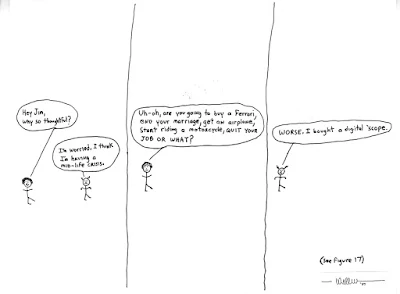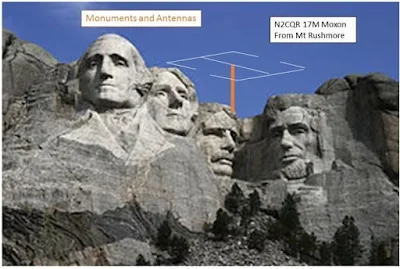Attentive listeners have probably noticed that for some time
now the podcast has been drifting in a new direction. Some have been concerned by this change. I myself, as you know, have shared in many of
these misgivings. But I have become convinced
that it is time for a major change in direction. We've been doing this for more than ten years -- we are one of the oldest ham radio podcasts. It is time for a change.
A number of people have encouraged me to make to this
change. My co-host Pete Juliano N6QW is
clearly the main influence. Pete has
made me see the errors of my Ludite ways. He taught me that it is time to put away the
Dymo tape and get with it with glowing numerals. Whenever I started getting enthused about VXOs
or about Permeability Tuned Oscillators using brass screws moving through hand-wound
coils, Pete was there to remind me of the beauty, simplicity, and efficiency of
Arduino Microcontrollers and Si5351 chips.
Paul Darlington M0XPD contributed an element of old world legitimacy to
this push for modernity. Tom Hall AK2B was another influence -- whenever I was
on the verge of quitting, he’d Skype in from the Big Apple and get me back on
the digital track. And we can’t forget
Farhan over in India – as soon as he started putting Arduinos and Si570s in his
Minima, I knew this was really, as the kids say, “a thing.”
So anyway, it is time for a change. I know
many of you may find this shocking, so it is probably best for me to just go
ahead and say it: We are changing the name of the podcast and we are changing its
focus.
n
Instead
of SolderSmoke, the new name will be “WireWrapRap.” Wire wrap is the solder-less wiring technique often used in computer circuitry. We hope that the “Rap” thing will be
especially helpful in attracting young people – especially those Maker Millennials
-- to the show. And, you know, soldering
just seems so 20th century.
n
Instead
of traditional homebrew radio, the show will be focused on Mini Computers
(especially the Raspberry Pi), Software Defined Radio, Digital Signal Processing,
Microcontrollers (especially the Arduino), and the use of smart phones in ham
radio
n Obviously this implies a move away from minimalist radio and QRP. So yes, we are going maximalist and we are going QRO. And we are getting more involved in contesting (see below).
Now I know what some of you are thinking – that this must be
part of our long-standing quest for sponsorship and that this is all about
money. But that’s only part of it. Yes, we have secured a lucrative sponsorship arrangement
with a company involved in microcontrollers, small computers and smart phones that
is focused on the millennial market. But
we’re really doing this for the good of our listeners.
Don’t worry, you will find many of your favorite parts of
SolderSmoke in the new show. They will
be the same, only different. For
example, instead of the “Bandsweep” segments that we used to do, now we are
going to have “Codesweep” (and it’s not about
Morse). Where we used to have
SolderSmoke Mailbag, well, don’t worry -- we are going to continue to have a
segment that will allow for listener input.
We going to call it “Pi Hole.” We’ll
only be accepting listener input via TEXT messages or Tweets – we are, after
all, trying to be modern. Along the same lines, we will be distributing the podcast exclusively via Soundcloud. So get with it gentlemen! Get into the cloud!
In the new and improved podcast we want to explore the new
and exciting digital modes. We plan
segments on all the new ones: PSK-99, Opera, WSPR, SNICKR, Throb, Thor,
Piccolo, Oreo, Oregano, you know, all
those weird sounds you’ve been hearing near what used to be considered the CW
portion of the band. It will be such
fun! I can’t wait to decode some
Oregano!
Smart phones, are, of course, the future of ham radio, and
we intend to be fully into those little magic boxes. I don’t know if you guys realize it, but all
of that ugly dusty junk in your shack can be replaced by a few lines of code
from the App Store. That room you used to
call “the shack” can be converted into the Yoga studio or knitting room that
your wife has been longing for! Now you can
carry your station with you wherever you go and autonomously participate in
contests from stations around the world.
Imagine the thrill of learning that while you were playing golf or bowling, you
were also WINNING a major DX contest from a “station” in Ulan Bator. And that
ALL of your reports were 59! It’s like
owning your own ham radio drone! Congrats
old man. YOU WON! Welcome to the 21st
century! That’s the kind of operation we are going to explore on WireWrapRap!
For those of you who are worrying that we might be
abandoning our microphones, have no fear my friends, Pete and I remain
committed phone operators. Only now, it will be DIGITAL VOICE. We’ll be squeezing our dulcet tones into a
mere 800 Hz of bandwidth. This way we
both sound exactly the same. Heck with
this new technology everybody will sounds
the same. How cool is that! We’ll all sound like a mix of Stephen
Hawking’s synthesizer, Apple’s Siri, and MTV's Max Headroom. The AM guys and the Enhanced SSB crew may
need some time to get used to this, but c’mon fellas, it is time to get with
it! There will be no more need to tweak
all those menus for “presence” and “brightness” and “mid-range.” Heck no, we’ll all sound the same! Progress my friends, PROGRESS!
As I said, I had my doubts about this. But over the weekend I walked into the TV
room and Elisa happened to be watching one of those “inspirational self-help”
speakers on Direct TV, and you know what?
He made a lot of sense. Change IS good!
We have to EMBRACE the future!
Impossible = “I’m possible!”
Yea! So thank you Deepak Chopra! Thank you Pete Juliano! And welcome -- all of you -- to the WireWrapRap!


























































